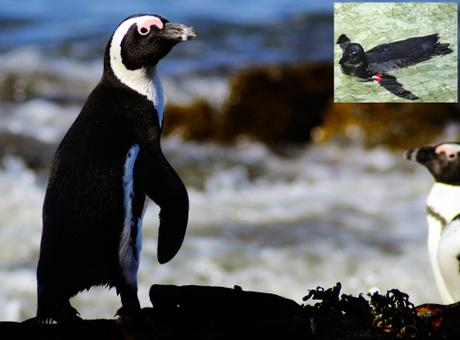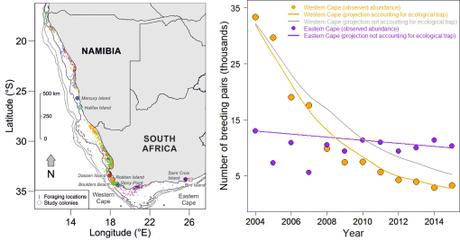Jorge Drexler sings “… I was committed not to see what I saw, but sometimes life is more complex than what it looks like …”*. This excerpt by the Oscar-winning Uruguayan singer seems to foretell the theme of this blog: how the ecological complexity of marine ecosystems can elicit false signals to their predators. Indeed, the fidelity of marine predators to certain feeding areas can turn demographically detrimental to themselves when the amount of available food shrinks. A study of jackass penguins illustrates the phenomenon in a context of overfishing and ocean warming.

Adult of jackass penguin (Spheniscus demersus) from Robben Island (South Africa) — in the inset, one of the first juveniles released with a satellite transmitter on its back. The species is ‘Endangered’ under IUCN’s criteria (28), following a recent halving of the total population currently estimated at ~ 80,000 adults. Jackass penguins are the only penguins living in Africa, and owe their common name to their vocalisations (you can hear their braying sounds here); adults are ~ 50 cm tall and weigh ~ 3 kg. Photos courtesy of Richard Sherley.
Surface temperature, dissolved oxygen, acidity and primary productivity are, by and large, the top four environmental factors driving the functionality of marine ecosystems (1). Growing scientific evidence supports the idea that anthropogenic warming of the atmosphere and the oceans correlates with this quartet (2). For instance, marine primary productivity is enhanced by increased temperatures (3), but a warmer sea surface intensifies stratification, i.e., stacked layers of seawater with contrasting physical and chemical properties.
In coastal areas experiencing ‘upwelling’ (where winds displace surface water, allowing deep water laden with nutrients to reach the euphotic zone where plankton communities feast), stratification weakens upwelling currents and, in turn, limits the growth of plankton (4) that fuels the entire trophic web, including our fisheries. The study of these complex trophic cascades is particularly cumbersome from the perspective of large marine predators because of their capacity to move long distances, from hundreds to thousands of kilometres (5), with strong implications for their conservation (6).
With those caveats in mind, Richard Sherley and colleagues satellite-tracked the movement of 54 post-fledged, juvenile jackass penguins (Spheniscus demersus) for 2-3 years (7). All individuals had been hatched in eight colonies (accounting for 80% of the global population), and were equipped with platform terminal transmitters. Jackass penguins currently nest in 28 island and mainland locations between South Africa and Namibia. Juveniles swim up to 2000 km in search of food and, when approaching adulthood, return to their native colonies where they reproduce and reside for the remainder of their lives (watch individuals swimming here).
The natural history of this species is linked to the Southern Hemisphere’s trade winds (‘alisios’ for Spanish speakers), which blow from the southeast to the tropics. In the South Atlantic, trade winds sustain the Benguela Current, the waters of which surface from some 300 m of depth and fertilise the marine ecosystems stretching from the Western coasts of South Africa to Angola (8).

Left panel: Migratory movements (colours) of 54 satellite-tracked juveniles of jackass penguins (Spheniscus demersus) between their natal colonies (circles) and feeding areas (vertical bars) (7). Young birds from the Atlantic Ocean colonies (Western Cape) consistently migrate to the north, and those from the Indian Ocean colonies (Eastern Cape) migrate to the west. Right panel: Demography of breeding pairs, where points represent annual numbers of pairs, and lines are projections based on survival rates accounting or not for an ecological trap. Projections support that hypothesis that reproductive pools west and east of the Cape Agulhas have declined, although only in the former is an ecological trap operating.
Sherley and colleagues found that between May and July (autumn-winter), the juvenile penguins from the six Atlantic-Ocean colonies (Western Cape) migrated northwards, while those from the two Indian-Ocean colonies (Eastern Cape) migrated westwards to Cape Agulhas (7) — the geographical point that separates both oceans. At destination, these birds encountered a bounty of food in the form of schools of South American pilchard (Sardinops sagax) and European anchovy (Engraulis encrasicolus). However, from August to September (beginning of spring), two environmental challenges appear to have lowered the survival rates of jackass penguins from the Atlantic colonies alone:
- Many areas along the Benguela Current are experiencing a surprising spatial uncoupling between phytoplankton and planktivorous fish (9). When pilchards and anchovies attain reproductive age, they seem to migrate southwards to spawn in the warmer (and warming) waters off Cape Agulhas (10, 11); yet, penguins do not follow their prey.
- Fish stocks north of the Benguela Current have not recovered from overfishing that peaked in the mid-20th Century, the ecosystem having undergone a gradual ‘jellyfication’ whereby jellies replaced fish as the predominant pelagic fauna (12); yet, penguins keep migrating to this area now mostly devoid of their prey.
Both overfishing and prey migration to warmer waters could have created an ecological trap** (13, 14) for jackass penguins in that their postnatal migration might be responding to an environmental signal that is no longer associated with the abundance of their prey.
What could that signal be? Adult jackass penguins are mainly visual hunters of fish schools (see fishing footage here). In contrast, and like many Procelariiformes (15, 16), penguin juveniles could also be guiding their migration by olfactory cues, so preferring areas with high concentrations of dimethyl sulphide (17): a chemical compound smelling very much like a clam display in the local fish market. The compound is released by phytoplankton as they are grazed by zooplankton.
This begs the hypothesis that young penguins might smell the phytoplankton, and relate it to potential prey, which are no longer numerous. Meanwhile, adult jackass penguins do not fall into this hypothetical ecological trap and consistently forage in (18), and exclude juveniles from (19), prey-rich waters — perhaps because they store geographical feeding information in their spatial memory accumulated over the full life cycle (see a review about this theme in reference 20).
A synergy between overfishing and climate change has exacerbated the variability of the marine ecosystems in the Benguela Current (10, 21). There (like in the other main fishing areas worldwide), forage fish is one of the most heavily exploited marine resources (22), and a key component of marine food webs. Forage fish comprise pelagic species of gregarious and small-bodied crustaceans and fish, like krill, sardines and anchovies. They amount to one third of the global fishery catch, of which one third is destined for human consumption, while the rest goes to feeding livestock (23) and is also exploited as fish bait, fertilisers, and food for farmed fish and pets. The reality is that many marine predators, like penguins, might be having their reproductive success compromised by competing with humans for resources such as forage fish (24), and this competition is doomed to strengthen in the future.
While our society has exceeded the limits of sustainable fisheries (25), overfishing (see popular-science video here) is not, and will not be, alien to climate change. Thus, current predictions estimate that fish catches are bound to decline by three million tonnes with each one degree of warming (2). That is a lot of fish considering that the current annual fishery catch totals > 80 million tonnes globally*** and keeps diminishing (27). It sounds trivial to end this blog by saying that natural resources are limited, and limiting, for so many mouths.
*Original Spanish lyrics: “… yo estaba empeñado en no ver lo que vi, pero a veces la vida es más compleja de lo que parece …”. Full song available here.
**Ecological traps in simple words explained here and here by Bruce Robertson.
***Per capita human consumption of fish recently estimated at 20 kg/year by the United Nation’s Food and Agriculture Organization/FAO (26).
—
by Salvador Herrando-Pérez & David R. Vieites
(with support of the British Ecological Society and the Spanish Ministry of Economy, Industry and Competitiveness)
References
- Bopp, L et al. (2013) Multiple stressors of ocean ecosystems in the 21st century: projections with CMIP5 models. Biogeosciences 10: 6225-6245
- Cheung, WWL et al. (2016) Large benefits to marine fisheries of meeting the 1.5°C global warming target. Science 354: 1591-1594
- Chavez, FP et al. (2011) Marine primary production in relation to climate variability and change. Annu Rev Mar Sci 3: 227-260
- Behrenfeld, MJ et al. (2006) Climate-driven trends in contemporary ocean productivity. Nature 444: 752-755
- Hays, GC et al. (2016) Key questions in marine megafauna movement ecology. Trends Ecol Evol 31: 463-475
- Runge, CA et al. (2014) Conserving mobile species. Front Ecol Environ 12: 395-402
- Sherley, RB et al. (2017) Metapopulation tracking juvenile penguins reveals an ecosystem-wide ecological trap. Curr Biol 27: 563-568
- Hutchings, L et al. (2009) The Benguela Current: An ecosystem of four components. Prog Oceanogr 83: 15-32
- Grémillet, D et al. (2008) Spatial match–mismatch in the Benguela upwelling zone: should we expect chlorophyll and sea-surface temperature to predict marine predator distributions? J Appl Ecol 45: 610-621
- Jarre, A et al. (2015) Synthesis: climate effects on biodiversity, abundance and distribution of marine organisms in the Benguela. Fish Oceanogr 24: 122-149
- Mhlongo, N et al. (2015) Have the spawning habitat preferences of anchovy (Engraulis encrasicolus) and sardine (Sardinops sagax) in the southern Benguela changed in recent years? Fish Oceanogr 24: 1-14
- Roux, J-P et al. (2013) Jellyfication of marine ecosystems as a likely consequence of overfishing small pelagic fishes: lessons from the Benguela. Bull Mar Sci 89: 249-284
- Hale, R & SE Swearer (2016) Ecological traps: current evidence and future directions. Proc R Soc B 283: 20152647
- Robertson, BA et al. (2013) Ecological novelty and the emergence of evolutionary traps. Trends Ecol Evol 28: 552-560
- Nevitt, GA et al. (1995) Dimethyl sulphide as a foraging cue for Antarctic Procellariiform seabirds. Nature 376: 680-682
- Savoca, MS & GA Nevitt (2014) Evidence that dimethyl sulfide facilitates a tritrophic mutualism between marine primary producers and top predators. Proc Natl Acad Sci USA 111: 4157-4161
- Wright, KLB et al. (2011) Penguins are attracted to dimethyl sulphide at sea. J Exp Biol 214: 2509-2511
- Sherley, RB et al. (2013) The initial journey of an Endangered penguin: implications for seabird conservation. End Spec Res 21: 89-95
- Ryan, PG et al. (1987) Intraspecific mimicry and status signals in juvenile African penguins. Behav Ecol Sociobiol 20: 69-76
- Fagan, WF et al. (2013). Spatial memory and animal movement. Ecol Lett 16: 1316-1329
- Blamey, LK et al. (2015) Ecosystem change in the southern Benguela and the underlying processes. J Mar Syst 144: 9-29
- Pinsky, ML et al. (2011) Unexpected patterns of fisheries collapse in the world’s oceans. Proc Natl Acad Sci USA 108: 8317-8322
- Alder, J et al. (2008) Forage fish: from ecosystems to markets. Annu Rev Environ Resourc 33: 153-166
- Cury, PM et al. (2011) Global seabird response to forage fish depletion — one-third for the birds. Science 334: 1703-1706
- Worm, B & TA Branch (2012) The future of fish. Trends Ecol Evol 27: 594-599
- Food and Agriculture Organization (2016) The State of World Fisheries and Aquaculture (Roma, Italy), pp. 200
- Pauly, D & D Zeller (2016) Catch reconstructions reveal that global marine fisheries catches are higher than reported and declining. Nat Comm 7: 10244
- Crawford, RJM et al. (2011) Collapse of South Africa’s penguins in the early 21st century. Afr J Mar Sci 33: 139-156

